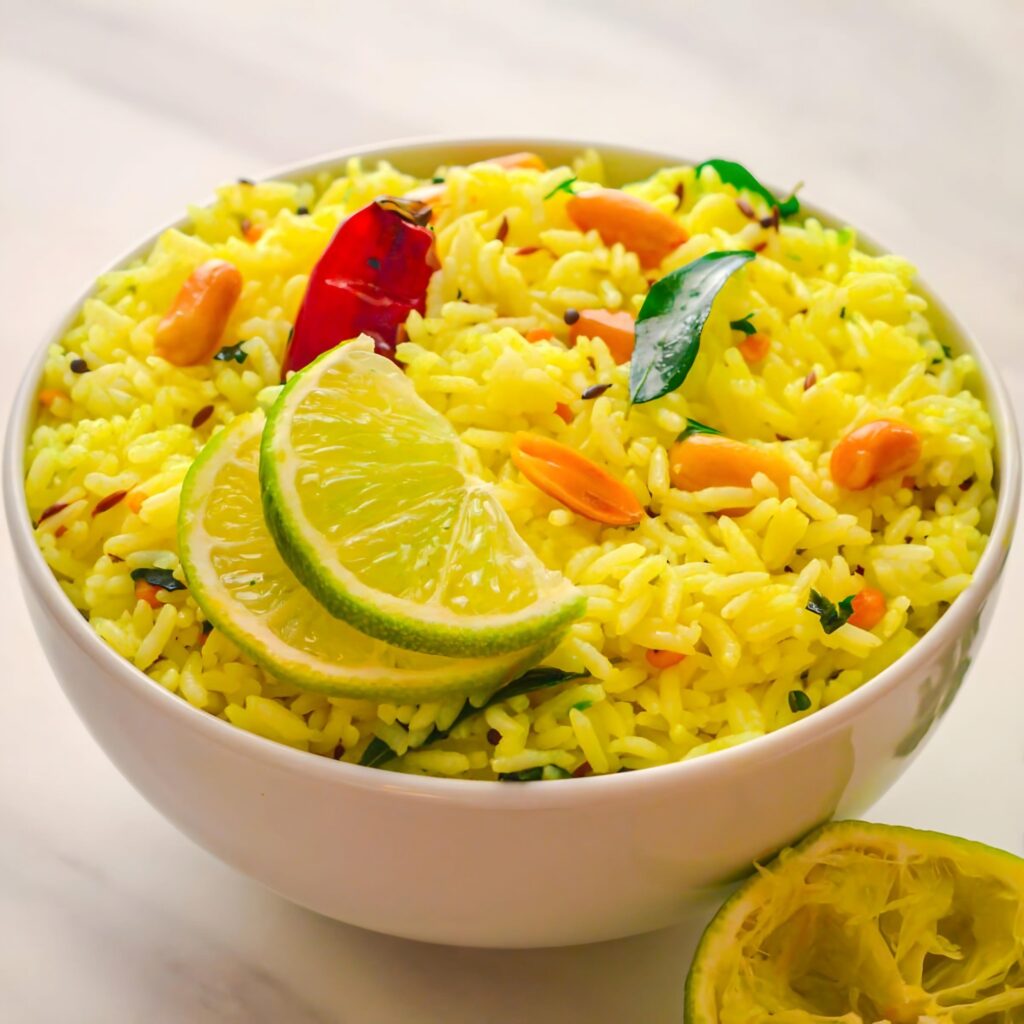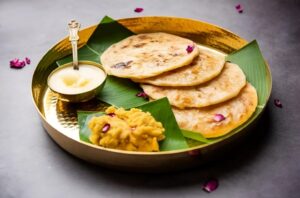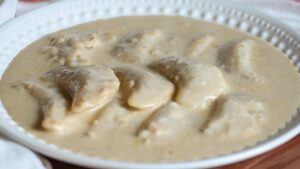Home Recipe of Lemon Rice – Treditional Sounth Recipe

Lemon rice, also known as “Chitranna” in Kannada or “Nimmakaya Pulihora” in Telugu, is a vibrant South Indian rice dish seasoned with aromatic spices, crunchy nuts, and tangy lemon juice. This dish is not only easy to prepare but also highly flavorful and satisfying. It’s a popular choice for lunch boxes, quick meals, and picnics. The recipe is versatile and can be customized with additional ingredients like vegetables, lentils, or fresh herbs.
Ingredients:
For the Rice:
- 1 cup basmati or sona masoori rice(regular white rice works too)
- 2 cups water
- 1 tablespoon oil(optional, to keep the rice grains separate)
- Salt to taste
For the Lemon Rice Tempering (Tadka):
- 2 tablespoons oil(preferably peanut oil, but sunflower or any neutral oil works)
- 1 teaspoon mustard seeds
- 1 tablespoon urad dal (split black gram)
- 1 tablespoon chana dal (split Bengal gram)
- 2 dried red chilies
- 1-2 green chilies, slit(adjust according to your spice level)
- 1 teaspoon turmeric powder
- 1 sprig curry leaves(fresh curry leaves give a distinct flavor)
- A pinch of asafoetida (hing)
- 2 tablespoons roasted peanuts or cashews(adds crunch to the dish)
For Flavoring:
- 2-3 tablespoons freshly squeezed lemon juice(adjust to taste)
- Salt, to taste
- 2 tablespoons freshly grated coconut(optional)
- Fresh coriander leaves (cilantro) for garnish(optional)
Instructions:
Step 1: Preparing the Rice
- Rinse the rice: Wash 1 cup of rice under cold water until the water runs clear. This step removes excess starch, ensuring that the rice grains don’t stick together.
- Cook the rice: In a medium-sized pot, bring 2 cups of water to a boil. Add the rinsed rice and a pinch of salt. If you prefer, you can add 1 tablespoon of oil at this stage to ensure the rice grains remain separate. Cook the rice on medium heat until all the water is absorbed and the rice is tender. This usually takes around 12-15 minutes for basmati rice and about 18-20 minutes for sona masoori rice.
- Tip: If you’re using a rice cooker, simply follow the manufacturer’s instructions. Alternatively, you can cook the rice in an Instant Pot or pressure cooker.
- Fluff the rice: Once the rice is cooked, fluff it gently with a fork and spread it out on a large plate or tray to cool down. Cooling the rice helps prevent it from becoming mushy when you mix in the tempering. Allow the rice to cool for at least 10-15 minutes.
Step 2: Preparing the Tempering (Tadka)
- Heat oil: In a large pan or wok, heat 2 tablespoons of oil on medium heat. Traditionally, peanut oil is used for its rich flavor, but any neutral oil will work.
- Add mustard seeds: Once the oil is hot, add 1 teaspoon of mustard seeds. Let them splutter for a few seconds. This step releases the aromatic oils in the mustard seeds, infusing the oil with a nutty flavor.
- Add dals and peanuts/cashews: Next, add 1 tablespoon each of urad dal and chana dal. Fry them until they turn golden brown. These dals add texture and crunch to the lemon rice. At this point, you can also add 2 tablespoons of peanuts or cashews for additional crunch. Fry the peanuts until they’re lightly golden.
- Add dried red chilies and curry leaves: Break the dried red chilies into halves and toss them into the pan. Add the fresh curry leaves (a sprig or about 8-10 leaves). Be careful as the curry leaves may splatter when they hit the hot oil. Stir for 10-15 seconds until fragrant.
- Add green chilies and asafoetida: Slit the green chilies lengthwise and add them to the tempering. Stir well and sauté for a minute. Add a pinch of asafoetida (hing), which adds a subtle umami note to the dish. Sauté for another 10-15 seconds.
Step 3: Flavoring the Rice
- Add turmeric powder: Lower the heat and add 1 teaspoon of turmeric powder to the tempering. Turmeric not only gives the lemon rice its vibrant yellow color but also provides an earthy, slightly bitter flavor that balances the tanginess of the lemon juice. Stir the turmeric into the oil mixture, ensuring it’s evenly distributed.
- Add cooked rice: Add the cooled rice to the pan. Gently mix it with the tempering, making sure the rice is evenly coated with the turmeric and spices. Be gentle while mixing to avoid breaking the rice grains.
- Add salt and lemon juice: Sprinkle salt to taste and drizzle the freshly squeezed lemon juice over the rice. Stir well to ensure the lemon juice is evenly mixed with the rice. The amount of lemon juice can be adjusted based on your preference for tanginess. Start with 2 tablespoons and add more if needed.
Step 4: Finishing Touches
- Optional ingredients: If using, add 2 tablespoons of freshly grated coconut to the lemon rice for a hint of sweetness and texture. You can also sprinkle some finely chopped coriander leaves for a fresh herbal note.
- Check seasoning: Taste the lemon rice and adjust the salt, lemon juice, or spices if needed. The balance of flavors should be tangy from the lemon, mildly spiced from the chilies, and aromatic from the tempering.
Step 5: Serving Lemon Rice
- Garnish: Before serving, you can garnish the lemon rice with a few more roasted peanuts or cashews for extra crunch. A sprinkle of freshly chopped coriander leaves (cilantro) also adds color and flavor.
- Serving suggestions: Lemon rice can be served hot or at room temperature, making it an ideal dish for various occasions. It pairs well with:
- Plain yogurt or raita (a spiced yogurt dish)
- Papad (crispy lentil crackers)
- Pickles (especially mango or lime pickles)
- A side of fried or roasted vegetables, such as potato or plantain fry
- A cooling cucumber salad with a dash of salt and lemon juice.
Tips for Making Perfect Lemon Rice:
- Rice consistency: The texture of the rice is key to good lemon rice. Ensure that the rice is cooked but not mushy. It should be fluffy and each grain should remain separate. If you’re worried about overcooking the rice, you can slightly undercook it since it will cook further when mixed with the tempering.
- Cooling the rice: Spread the rice on a large plate or tray to cool it quickly. If you’re short on time, place the rice under a fan or cool it in the refrigerator for a few minutes.
- Balance of flavors: The beauty of lemon rice lies in the balance of tangy, spicy, and nutty flavors. Adjust the lemon juice, chilies, and salt according to your taste preferences. If the rice feels too tangy, you can balance it out with a little sugar or reduce the amount of lemon juice.
- Variations: While the traditional lemon rice recipe uses basic ingredients, you can customize it by adding vegetables like finely chopped carrots, peas, or bell peppers. These vegetables not only add color but also increase the nutritional value of the dish. Another popular addition is roasted sesame seeds, which enhance the nutty flavor.
- Storage: Lemon rice stays well for up to 24 hours when stored in an airtight container in the refrigerator. It’s a great option for meal prep or packing for a picnic. You can reheat it in the microwave or on the stovetop with a few drops of water to refresh the flavors.
Conclusion:
Lemon rice is a vibrant, flavorful dish that showcases the simplicity and brilliance of South Indian cooking. With its bright yellow hue, fragrant tempering, and the perfect balance of tangy and spicy flavors, it’s a dish that can be enjoyed on its own or as a part of a larger meal. The versatility of this dish allows for endless customizations, and its quick preparation time makes it a go-to for busy days. Whether you’re looking for a light meal or a side dish for a larger spread, lemon rice is a delicious and satisfying choice.
FAQs for Lemon Rice Recipe
- Can I use any type of rice for lemon rice?
- Yes, you can use any type of rice, but traditionally, short-grain varieties like sona masoori or basmati rice are preferred for lemon rice. Ensure the rice is cooked to a fluffy consistency, with grains separated, so it doesn’t become mushy when mixed with the tempering.
- How can I prevent the rice from becoming mushy?
- To avoid mushy rice, rinse the rice thoroughly before cooking to remove excess starch. After cooking, spread the rice on a plate to cool it before mixing it with the tempering. You can also slightly undercook the rice, as it will cook further when combined with the tempering.
- Can I make lemon rice with leftover rice?
- Absolutely! Lemon rice is an excellent way to repurpose leftover rice. In fact, slightly dried-out, day-old rice works better because it tends to remain fluffy and doesn’t turn mushy when mixed with the spices and lemon juice.
- What can I use instead of peanuts or cashews?
- If you’re allergic to peanuts or don’t prefer nuts, you can skip them altogether. For added crunch, you can substitute them with roasted sunflower seeds, pumpkin seeds, or omit the crunch altogether if you prefer a nut-free version.
- How much lemon juice should I add to the rice?
- The amount of lemon juice depends on personal taste and the level of tanginess you prefer. Start with 2 tablespoons of freshly squeezed lemon juice and adjust as needed, adding more if you prefer a stronger lemon flavor.
- Can I add vegetables to the lemon rice?
- Yes, vegetables like finely chopped carrots, peas, bell peppers, or even cooked potatoes can be added to make the dish more wholesome. Sauté the vegetables with the tempering until they are tender before adding the cooked rice.
- Is lemon rice spicy?
- Lemon rice has a mild spice level. The green chilies and dried red chilies in the tempering add a bit of heat, but you can adjust the quantity of chilies based on your spice tolerance. If you prefer it less spicy, reduce the number of chilies or omit them.
- What can I serve with lemon rice?
- Lemon rice can be served on its own or with accompaniments like plain yogurt, raita, papad, pickles, or fried or roasted vegetables. A simple cucumber salad with a sprinkle of salt and lemon juice also complements the dish well.
- Can I use lime juice instead of lemon juice?
- Yes, lime juice can be used as a substitute for lemon juice. Both provide a tangy flavor, though lime juice might have a slightly more intense tartness. Adjust the amount of lime juice according to your taste preferences.
- How do I store and reheat lemon rice?
- Store lemon rice in an airtight container in the refrigerator for up to 24 hours. To reheat, sprinkle a few drops of water over the rice to prevent it from drying out and microwave it, or reheat it on the stovetop in a pan with a little oil.
- Can I freeze lemon rice?
- While it’s best consumed fresh or refrigerated, you can freeze lemon rice in an airtight container for up to 1 month. To reheat, thaw it in the refrigerator overnight and microwave or reheat it on the stove with a little water or oil.
- What is the role of turmeric in this recipe?
- Turmeric gives lemon rice its signature yellow color and imparts an earthy, slightly bitter flavor that balances the tartness of the lemon juice. It also adds a subtle health benefit, as turmeric is known for its anti-inflammatory properties.
- Can I make lemon rice without oil?
- Oil is crucial for the tempering process, which infuses the dish with flavor. However, if you’re looking for a lower-fat version, you can reduce the amount of oil used or use a non-stick pan to minimize the oil needed for tempering.
- What is the purpose of asafoetida (hing) in lemon rice?
- Asafoetida, or hing, adds a subtle umami flavor to lemon rice. It enhances the overall taste by bringing out the flavors of the spices and dals used in tempering. If you don’t have asafoetida, you can omit it without drastically altering the flavor.
- Can I use pre-cooked rice for lemon rice?
- Yes, pre-cooked or leftover rice works great for lemon rice. Just make sure the rice is cooled and the grains are separated before mixing it with the tempering. Using pre-cooked rice makes this dish quick and convenient to prepare.
- Is lemon rice gluten-free?
- Lemon rice is naturally gluten-free as long as you ensure that the asafoetida (hing) used is gluten-free. Some commercial brands of asafoetida contain wheat, so check the label if you’re following a strict gluten-free diet.
- Can I substitute curry leaves in this recipe?
- Curry leaves are a key ingredient in lemon rice, adding a unique fragrance and flavor. If you don’t have curry leaves, there isn’t a direct substitute, but you can proceed without them. However, the dish might lack its signature aromatic depth.
- What are the nutritional benefits of lemon rice?
- Lemon rice is a good source of carbohydrates, provides some protein from the lentils, and offers vitamins and minerals from ingredients like turmeric and lemon juice. Adding peanuts or cashews increases the healthy fat and protein content, while vegetables can boost fiber and nutrient levels.
- Can I make lemon rice in a rice cooker or Instant Pot?
- Yes, you can cook the rice in a rice cooker or Instant Pot for convenience. Once the rice is cooked, prepare the tempering separately in a pan and mix it with the rice. If using an Instant Pot, you can even do the tempering using the sauté mode before mixing in the cooked rice.
- What can I do if my lemon rice turns out too tangy?
- If your lemon rice is too tangy, you can balance the flavors by adding a little sugar or more salt to mellow the acidity. You could also mix in a bit more cooked rice to dilute the strong lemon flavor.







